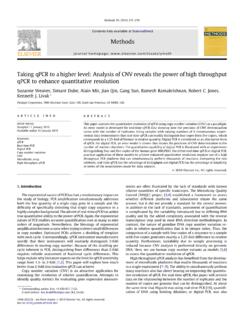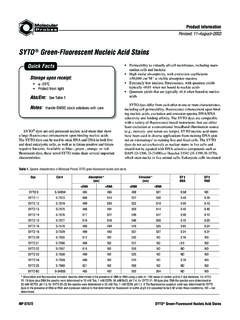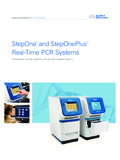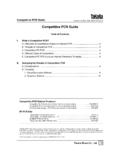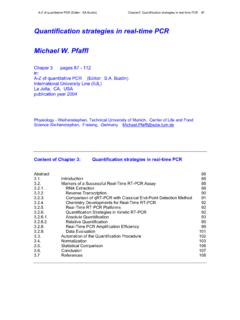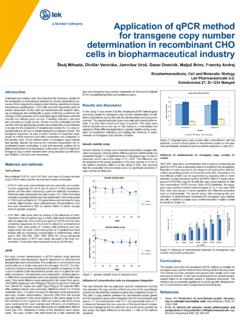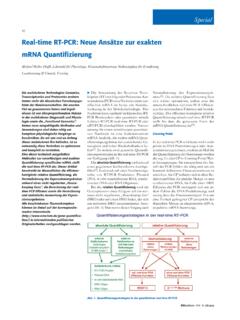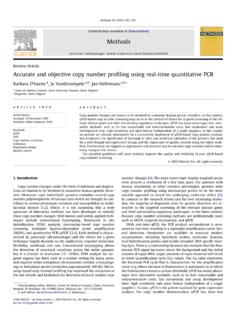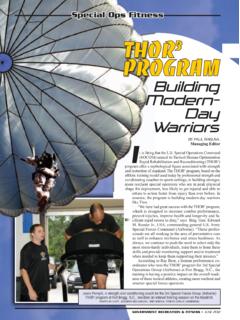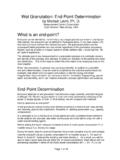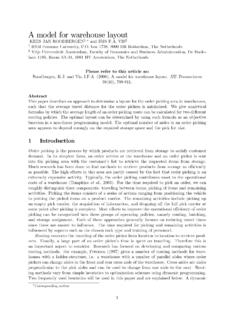Transcription of High Resolution Melting: Optimization Strategies
1 LightCycler 480 Real-Time PCR SystemTechnical Note No. 1 High Resolution Melting: Optimization StrategiesHigh Resolution melting (HRM) is a novel, closed-tube, post-PCR technique allowing genomic researchers to easily analyze genetic variations in PCR amplicons. This technical note describes general steps of setting up HRM-based PCR assays, with a special focus on ways how to optimize procedures for gene scanning LC 480 TN 14:01:2222 High Resolution Melting: Optimization StrategiesThe novel High Resolution Melting (HRM) tech-nique enables researchers to rapidly and efficiently discover genetic variations ( , SNPs, mutations, methylations). HRM provides outstanding specific-ity and sensitivity with high sample throughput. Using the LightCycler 480 Real-Time PCR System, PCR and analysis can be performed on one instru-ment, which is convenient, saves time and reduces costs.
2 Currently, the main application for the High Reso-lution Melting method is gene scanning, , the identification of heterozygotes in order to discover new variations in target-gene-derived PCR ampli-cons (Figure 1). Introduction Overview of High Resolution Melting PrincipleIn High Resolution Melting experiments, the target sequence is amplified by PCR in the presence of a saturating fluorescent dye ( , LightCycler 480 ResoLight Dye) (Figure 2). As with any dye used in melting experiments, the HRM dye fluoresces strongly only when bound to dsDNA. This change of fluorescence during an experiment can be used both to measure the increase in DNA concentration during PCR ampli-fication and, subsequently, to measure tempera-ture-induced DNA dissociation during High Reso-lution PCR in the presence of the dsDNA-binding fluorescent dye, amplicons are briefly denatured and then rapidly reannealed.
3 If the DNA sample is heterozygous, perfectly matched hybrids (homodu-plexes) and mismatched hybrids (heteroduplexes) are formed (Figure 3).When the temperature is slowly increased again, the DNA begins to melt. Fluorescent signal from a heterozygous DNA sample shows a decrease at two characteristic temperatures, due to the different rates of strand separation in heteroduplex and homoduplex dsDNA (Figure 3). Thus, the shapes of Figure 2: LightCycler 480 ResoLight Dye bound to double-stranded DNA. Saturation of the amplicon leaves no room for relocation events during 1: High Resolution Melting is a refinement of melting curve analysis that uses a saturating DNA-binding dye. After the PCR amplification and subsequent melting under high Resolution conditions, the Gene Scanning Module in the LightCycler 480 Software processes the raw melting curve data to form a difference plot.
4 This method can reveal varia-tions between samples ( , mutations or DNA modifications) and display those variations on a graph that is easy to interpret. 3250 LC 480 TN 14:01:2433 Overview of High Resolution Melting Principle continued Setting up PCR for HRM-based Gene ScanningData derived from the High Resolution Melting curve must be analyzed sophistically to create meaningful results. This is true for all applications of High Resolution Melting, here just to mention gene scanning. Such analysis requires all experi-mental parameters to be rigorously controlled and highly reproducible from sample to sample. Thus, the first step in obtaining optimal results is choos-ing a real-time PCR instrument which can provide this reproducibility. The LightCycler 480 Instrument is an integrated, high-throughput real-time PCR platform fulfilling these requirements. Its innovative temperature con-trol technology ensures sample-to-sample repro-ducibility, due to its ability to homogeneously heat the entire thermal block (Figure 4).
5 All HRM experiments have one thing in common: results are highly dependent on the quality of the individual PCR product. Thus, the second step in obtaining optimal HRM results is setting the PCR up recommend the following steps when planning and performing any high Resolution melting experi-ment:1. Carefully design the experiment2. Choose the best primers3. Standardize sample preparation4. Optimize the reaction mixture5. Optimize the PCR and melting programs6. Analyze the experimental data with LightCycler 480 Gene Scanning Software7. Use additional tools and downstream techniques to get more detailed informationmelting curves obtained with homozygous and heterozygous samples, respectively, are significantly different. In fact, the HRM technique is so sensitive that, in most cases, it can even detect single base variations between homozygous 3: Because of a sequence mismatch, heteroduplex DNA melts at a different temperature than homoduplex DNA.
6 This tempera-ture difference can be detected in the presence of LightCycler 480 ResoLight Dye, present in the LightCycler 480 High Resolution Melting PCR Master 4: Comparison of temperature homogeneity over the multiwell plate on a LightCycler 480 Instrument or an instrument from another supplier. Data were collected during the heating phase of an HRM LC 480 TN 14:01:254 Setting up PCR for HRM-based Gene Scanning continued1. Carefully design the experimentGene Scanning allows you to screen defined sec-tions of DNA for any sequence variation or modifi-cation compared to other DNA samples. For an efficient screening assay, you must design your experiment following guidelines will help you design a gene scanning experiment to analyze a typical gene ( , the one in Figure 5): If the exon to be scanned is not too long (maxi-mum length 400 bp, ideally < 250 bp; , exons 3 6 in Figure 5), place the primers in the adja-cent introns.
7 This allows the entire exon to be scanned as a single amplicon. Longer exons ( , exon 2, Figure 5) should be divided in several segments ( , amplicons of approx. 300 bp each). Design the primers for these segments in a way that the amplicons overlap. If you want to analyze only certain hot spots or sites with a known polymorphism, short ampli-cons (<150 bp) are preferable. A single base vari-ation affects the melting behavior of a 100 bp amplicon more than that of a 500 bp amplicon; thus, short amplicons are more likely to show the effects of small sequence : It is possible to detect sequence variations with longer amplicons. Nevertheless, the influence of a variation on the melting curve shape decreases with an increasing amplicon length and amplicons >500 bp often exhibit a multiphase melting behav-ior, disturbing the variation detection (more than 2 melting domains will preclude proper analysis).
8 2. Choose the best primersTo obtain the best HRM results, not all pre- developed and published primers are optimally suited. Sometimes design of new primers and the Optimization according to the prerequisites of real-time PCR is recommended to generate better results faster. In general, parallel testing of more than one set of primers will increase the likelihood of quick access to gene these general guidelines: Use special software to design the primers, , Primer3 ( ), or LightCycler Probe Design Software Design PCR primers that have annealing tem-peratures around 60 C. Avoid sequences that are likely to form primer dimers or nonspecific products. BLAST ( ) the primer sequences to ensure they are specific for the target species and gene. Always use primers that have been purified by HPLC. Use low primer concentrations ( , 200 nM each) to avoid formation of unspecific products like , primer dimers.
9 Check the specificity of the PCR product ( , on an agarose gel). Remember that reactions containing primer dimers or nonspecific prod-ucts are not suitable for HRM 5: This typical gene, which has exons of differing lengths, requires careful placement of primers to get appropriate amplicons for the HRM LC 480 TN 14:01:265 Formation of secondary structures in single-strand-ed or partially denatured DNA can have an influ-ence on primer binding, amplification efficiency or subsequent may cause poor grouping or bad Resolution . Tools to predict secondary structure are available and may be used to analyse the sequence of interest. Please verify that the conditions used for the in silico analysis follow the conditions used within the PCR reaction. 3. Standardize sample preparation HRM compares amplicons from independent PCR reactions; therefore minimizing reaction-to-reac-tion variability is essential.
10 One way to minimize variability is to standardize the sample preparation procedure, , by doing the following: Use the same extraction procedure for all samples. Use nucleic acid preparation techniques that are highly reproducible. For example, you could use either: the MagNA Pure LC Instrument or the MagNA Pure Compact Instrument together with a de dicated nucleic acid isolation kit (for auto-mated isolation), or a High Pure nucleic acid isolation kit (for man-ual isolation), , the High Pure PCR Tem-plate Preparation Kit. Determine the concentration of the DNA samples using spectrophotometry, then adjust samples to the same concentration with the resuspension buffer. Use the same amount of template in each reaction (5 to 30 ng template DNA in a 20 l reaction). Check the Cp values and the height of the amplification curves for all samples (Figure 6).
